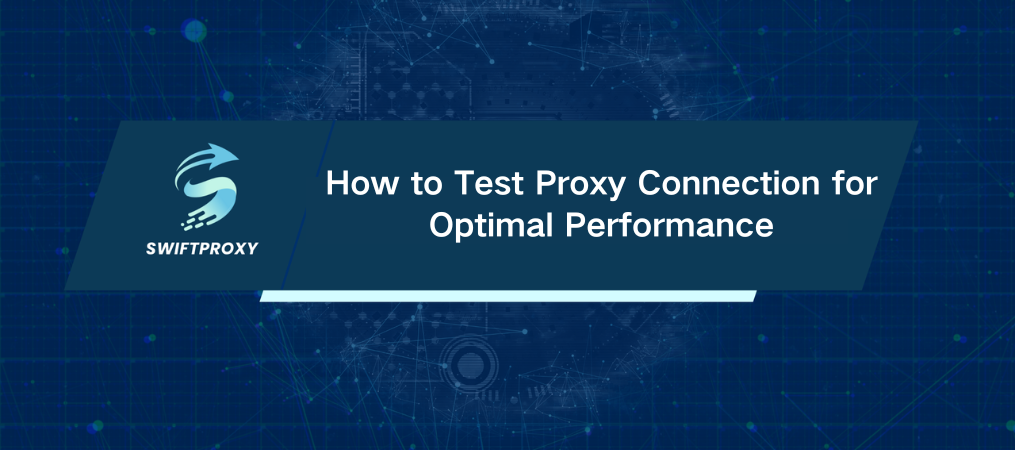How to Test Proxy Connection for Optimal Performance

When it comes to proxies, connectivity is everything. Think about it: if your proxy can't maintain a stable, fast connection, what's the point of even using it? Whether you're gathering data, bypassing geo-restrictions, or enhancing security, your proxy's effective connectivity is crucial to success. So, how do you test it?
Let's break it down step by step—no fluff, just actionable insights.
Step 1: Choose Your Test Target
Start by selecting the proxy you want to test. Record its IP address and port number. It's essential to ensure you're testing the correct one.
Step 2: Prepare Your Tools
You'll need a reliable HTTP proxy testing tool. Tools like Postman, Curl, or specialized software designed for proxy testing work well. The key here is ensuring the tool is configured to connect through your proxy server. Without that, the test won't be accurate.
Step 3: Test One Proxy IP
Here's where the rubber meets the road. Send multiple HTTP requests to your target website via the proxy. Look for successful connections and see if the proxy responds within a reasonable time frame. Record the results—successful connections versus failed ones. This gives you your first snapshot.
Step 4: Test Multiple Proxy IPs
If you're testing several proxies (as you often should), repeat the above process for each. List the IPs and ports, then perform the same test for each proxy. Record each result.
Step 5: Calculate Effective Connectivity Rate
Time for some math. For each proxy IP, calculate the Effective Connectivity Rate (ECR) using this formula:
Effective Connectivity Rate = (Number of Successful Connections / Total Number of Attempts) × 100%
This percentage is your golden metric. It tells you how often the proxy succeeds in connecting to your target.
Step 6: Evaluate Your Proxies
With all your data in hand, it's time to compare. Look at the overall performance of each proxy. Here are some key things to consider:
· Average Effective Connectivity Rate: What's the overall performance like across all your proxies? A higher average means better reliability.
· Individual Proxy Performance: Some proxies might outperform others. Focus on the ones that give you the best success rates.
· Connectivity Consistency: Does any proxy show big fluctuations over time? If so, it could be a sign of instability.
How to Test Proxyless Connection
Sometimes, you might want to test a proxyless connection, especially when you're bypassing a proxy entirely or checking for direct connectivity. Here's how:
1. Disconnect the Proxy
First, ensure your test device or application is not routing traffic through a proxy. You can either disable the proxy configuration in your settings or use a fresh network connection.
2. Test Direct Connectivity
Now, send HTTP requests directly to your target website, just as you would with a proxy. Observe how quickly the connection is established and the reliability of the response. Track success rates and any delays, much like you would in the proxy test.
3. Compare Results
The key here is comparison. How does the proxyless connection hold up in terms of speed, reliability, and success rate? You should compare these direct connection results with those from proxy tests to see how much of an impact the proxy makes.
What Makes a Proxy High-Connectivity
Now, let's talk about what sets high-performing proxies apart. When evaluating a proxy, here's what to look for:
1. Server Accessibility
A proxy with high connectivity should have highly available servers. These servers should perform well in various locations and be backed by solid network infrastructure. This ensures reliability, no matter where you're connecting from.
2. Geographic Coverage
A strong proxy service will have a wide range of server locations. The closer your proxy is to your target website's server, the faster and more reliable your connection will be.
3. Response Speed
Low response time is essential for speed. Proxies with quick response times can establish connections faster, ensuring smooth browsing or data scraping.
4. Connection Reliability
Frequent disconnections are a deal-breaker. A high-connectivity proxy maintains a steady connection over long periods. This is vital for tasks like data scraping, where reliability is non-negotiable.
5. Speed and Throughput
A fast proxy means faster load times and better overall user experience. Ensure that the proxy provides enough bandwidth to prevent throttling, which can slow you down.
6. Anti-Blocking Features
Finally, a great proxy can bypass blocks. Many websites actively block proxies, so choosing one with strong anti-blocking capabilities is critical. This feature can be the difference between consistent access and constant frustration.
Conclusion
Effective connectivity is a cornerstone of proxy performance. Whether you're gathering data, securing sensitive traffic, or simply trying to stay anonymous online, testing your proxy's connectivity can help you avoid frustration and ensure efficiency.
By following the steps above, you can test and evaluate proxies with precision. Look for providers with stable servers, fast speeds, and good anti-blocking features to get the most out of your proxy.
For those serious about data collection, Swiftproxy stands out as a trusted residential proxy provider. With high connectivity, global server distribution, and anti-blocking capabilities, they help businesses and individuals get the data they need, when they need it.
In the world of proxies, testing isn't just useful; it's essential.

















































